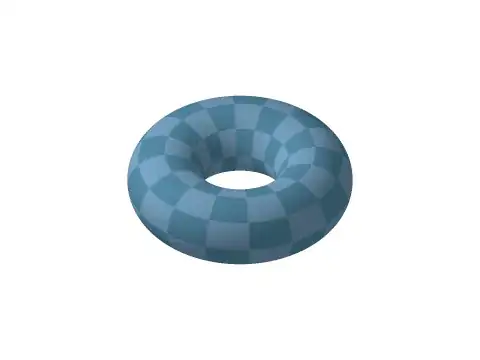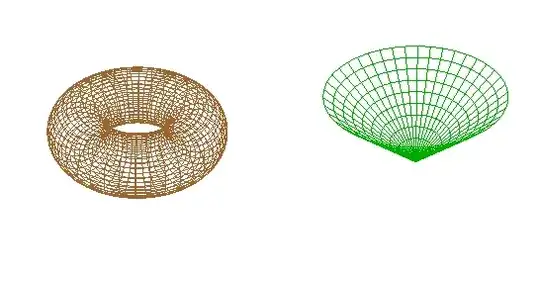I'm looking at "A Geometric Paradox" by B. H. Brown, in the May--June 1923 issue of The American Mathematical Monthly, pages 193--195. I think people studied advanced Euclidean geometry a lot more then than they do now. The author writes as if for an audience familiar with such material, and I don't think you'd do that in the Monthly now.
Brown reminds us that "a plane bitangent to a torus cuts it in two circles" (see Villarceau circles). That much I knew. He writes:
begin quote
- A cone of revolution can be inverted into a torus;
- The lines of curvature on a cone of revolution are the rulings and parallel circles;
- The lines of curvature on a torus are the meridian and parallel circles;
- Inversion carries lines of curvature into lines of curvature;
- Inversion carries circles into circles (straight lines being considered circles);
- Inversion preserves angles (except for sign).
If we then invert a cone into a torus, where can we find any circles on the cone to invert into the Villarceau circles?
end quote
So here we certainly have a seeming paradox!
Items 1 and 4 were unknown to me, and I find 1 a bit implausible. I tried unsuccessfully, although not very hard, to visualize it. I wondered where the center of inversion should be.
Then Brown gives some details:
begin quote
The inversion with center $(0,0,i)$ and power $-2$, whose equations are $$ \begin{array}{l} \bar x = \dfrac{-2x}{x^2+y^2+(z-i)^2}, \qquad \bar y=\dfrac{-2y}{x^2+y^2+(z-i)^2} \\[6pt] \bar z = i+\dfrac{-2(z-i)}{x^2+y^2+(z-i)^2} = \dfrac{i(x^2+y^2+z^2+1)}{x^2+y^2+(z-i)^2} \end{array}\tag{1} $$ will carry the (imaginary) cone $$ \bar x^2 + \bar y^2 + \frac12\bar z^2 =0\tag{2} $$ into the real torus $$ (x^2+y^2+z^2+1)^1 = 8(x^2+y^2).\tag{3} $$
end quote
I hadn't expected complex numbers to enter in this way, and without some context I'd have guessed that the manifold that he calls an imaginary cone would be a $2$-dimensional manifold over $\mathbb C$ if $\bar x,\bar y,\bar z$ are allowed to be in $\mathbb C$. But the context suggests otherwise. As nearly as I can GUESS, we should have $\bar z$ being real and $\bar x,\bar y$ being pure imaginaries, so that the circle of negative radius $-\bar z/\sqrt{2}$ would be a $1$-dimensional manifold over $\mathbb R$ not over $\mathbb C$, and thus topologically what we normally call a circle.
1. Does my GUESS make sense?
2. Is this way of doing inversive geometry in $\mathbb R^3$ by using polynomials in $\mathbb C[\bar x,\bar y,\bar z]$ in any sense a standard thing? (Brown seems to treat it as standard, so I'd guess people familiar with what went on in geometry in those days might think of it as somewhat standard.)
Note added on the evening of October 8th: The sort of metric geometry I've seen in $\mathbb C^n$ involves an inner product that's linear in one variable and conjugate-linear in the other, so that $\mathbb C^n$ becomes isometric to $\mathbb R^{2n}$. Later in this paper than the part I quoted, Brown writes:
[ . . . ] the inverses of one system of Villarceau circles are given as the intersections of the cone and the planes$$ x+iy=c;\qquad c\ne0,\tag{7} $$ and of the other system by the cone and the planes $$ x-iy=c;\qquad c\ne0,\tag{8} $$
This makes it look as if these are supposed to be circle on the "cone" $x^2+y^2+\frac12z^2=0$ in $\mathbb C^3$. So I'm wondering if Brown intended these "circles" to be $2$-manifolds? And how does one think about metric geometry, including things like curvature and angles, in such a setting? And is it only in that sort of setting that a cone of revolution can be inverted into a torus?

